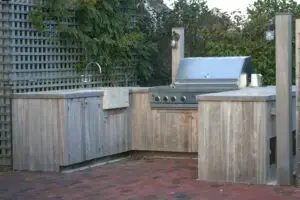Funny you should ask. To make a long story short…
There was a life before travelling to dissect and understand the successful ingredients of world-class private and public spaces. From the time I was 12, I cooked in high-end restaurant kitchens after school, weekends, and summers. Why I worked so much is a question for another time. That was long before designing swimming pools, gardens, and outdoor kitchens. At 19, I was on an internship from my culinary school. Placed at the Balsams Hotel in Dixville Notch, I worked for Austrian pastry chef Hermann Wayd. The Balsams is a classic 19th c. resort hotel in the same style as the Mount Washington in Bretton Woods. I asked Hermann if he would be my mentor and train me, but he said he wanted to retire. He suggested I go to Lech, Austria, where he had worked, and he would recommend me.
Cooking in France
Two years and a couple of restaurants later, I had earned a culinary degree. I flew out for Lech, sidestepping to see my brother who lived in Paris. He had worked in Austria and told me that without knowing German, I’d never get a job there. But, because I knew French, he suggested I work in France and learn German on the side, and then get to Austria.
I found a position in a small but fine restaurant, Au Chapeau Gris, in Versailles. That city, 10 miles west of Paris, is populated by very wealthy families and military garrisons.
In my time off I discovered Paris and its monuments. I roamed its parks and boulevards and tiny back streets, its courtyards and river walks, and the forests to the east and west. I naively thought someone should make places like these for the U.S.
Little did I know of the long history of landscape architecture around the world – F. L. Olmsted, A. Le Notre, A. Provost, T. Church, M. Van Valkenburgh, M. Schwartz.
Back to School
But I got hooked. No way, I thought, do people actually get to do this for a living? That next fall I entered the four-year landscape architecture program at UMass Amherst. I went on to three years of grad school at Harvard. Enduring hellish years, we survived through-the-night design charrettes, high pressure presentations, and a seemingly never ending run of a near-impossible load of coursework. In fact, one deranged program director in Cambridge who had it out for me suggested I find another vocation. It was tough. But her… encouragement… only caused me to knuckle down even more and bust through the remaining time to graduation. At the end of school, I was one of only three in my class to finish with a job offer in hand, and that was during a recession.
Work, and more work
A few years in Seattle, some time working in France again, this time for a top-name landscape architect, and about eight years in Boston working for great firms gave a foundation of broad experience. Licensing came along during those years, requiring three years of work in a licensed firm, and then a three-day, thirty-six hour sit down exam. Those years of work and licensure finally let me consider work on my own. I never really knew whether I’d start my firm, but just in case, I made a habit to gather materials that might be useful later on – contract samples, standard forms, specifications, procedures, methods, templates, all the minutiae one can glean from employers. It paid off.
Back home
When I opened Bartsch Landscape Architecture in 1999, it was in a sleepy town where, frankly, there was some money to spend on landscape. I moved back to my hometown where I’d gone from kindergarten through high school, and I thought I knew the community well enough to get a leg up.
Nantucket had changed over the years since my family moved there in the middle 60s. I visited my old home on Orange Street, about fifty feet from Main Street, and wondered at that fenced in front yard where we kept a horse (Flower), a pony (Tommy), two Dobermans (Jenny and Jody), two Iguanas (Brownie and Greenie), and two sheep (Bootsie and Lamb Chops). The town fathers quickly told us to move the animals out of town. So, we kept them all at Gibbie Wyer’s place by Tashama Farm, but the dogs and iguanas stayed at home. Gibbie had Guinea Hens and geese, ducks and chickens, a few other horses and a couple of cows. He’s gone now and his place is an overstuffed housing development where each home has about three square feet of lawn. Yes, the island has changed.
My business took off, and by now, a few years later, I’ve done over 175 projects on Nantucket, most of them a lot of fun. I’m gratified for all the good clients who have trusted me to do right by them. Of course plenty of evil types have taken advantage, but over all, people have been great and I’ve been lucky. With twenty-five or thirty years still to go in this profession, I trust I’ll have the pleasure of meeting many more great folks.
Next?
Maybe in the next lifetime I’ll get actually to Lech to work in that pastry shop. In the meantime, I’m forever reminded of the great places I’ve visited, and the incredible influences each holds for interpreting how we might compose our built spaces.




